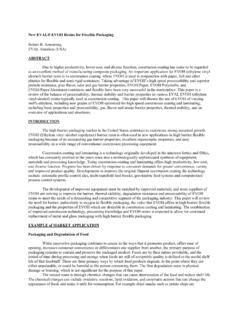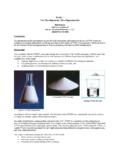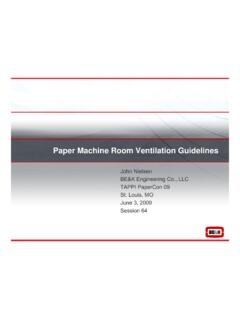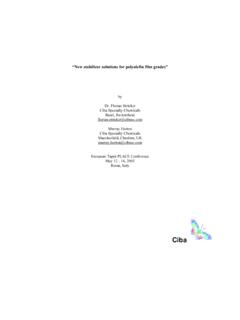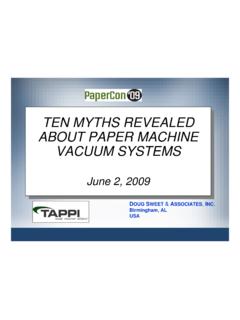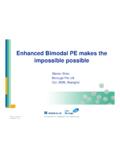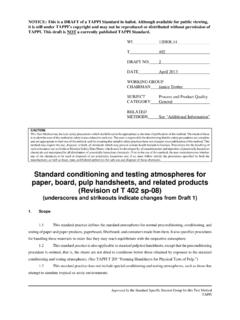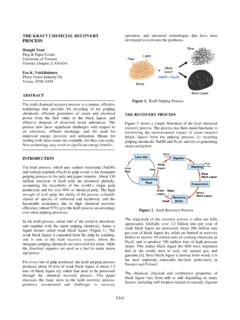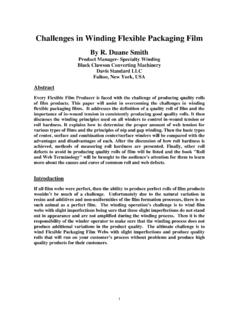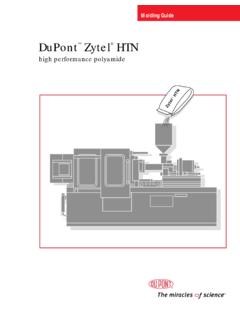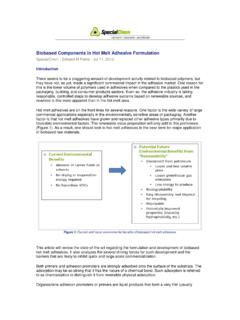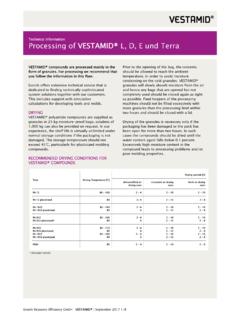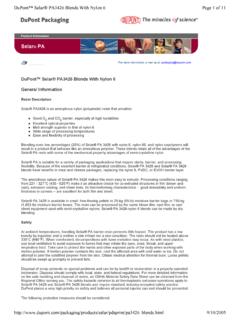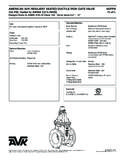Transcription of Polyamide for Flexible Packaging Film - TAPPI
1 Polyamide for Flexible Packaging film 2003 PLACE Conference 12 14 May 2003 Rome, Italy Dr. Walter Goetz, BASF AG, Ludwigshafen/Germany Abstract PA 6 is a widely used resin for the production of Flexible Packaging film , in most cases combined with polyolefins as a component of a multilayer structure. It has found numerous applications for its unique combination of properties like mechanical strength, transparency, thermoformability and barrier. This presentation summarizes the fundamental information about the chemistry and properties of nylon resins, their processing, and the properties and applications of Packaging film produced utilizing nylon. Polyamides may be processed into film by blown or cast film process, oriented or non-oriented. Standard extrusion equipment may be used, however post-treatment by humdidification or annealing helps to postcrystallize PA film and to achieve dimensionally stable, ready-to-use film of high quality.
2 Polyamide for Flexible Packaging film fig 1 1. Introduction Polyamide is widely used for the the production of Flexible film for Packaging of perishable food due to its unique combination of properties: fig 2: z mechanical strength z high heat distortion temperature z high flexibility and toughness z good barrier to oxygen, chemicals and aroma substances z high transparency z thermoformability fig 3 In 2002, about 260 000 t of polyamides, mainly PA 6 and copolyamides PA6/66, were used for Packaging film worldwide. Multilayer films in combination with PE, PP or EVOH form the major share of the Polyamide film market. fig 4 The term Polyamide describes a family of polymers which are characterized by the presence of amide groups. Since the first - and still most important - synthetic polyamides, PA66 (Nylon) and PA6 (Perlon), have been developed in 1938/39, they have found wide applications as film , fibers, engineering resins and others.
3 Today, DuPont s original brand name for PA66, Nylon , is often used as generic name for all synthetic polyamides. However, polyamides have been useful materials long before the development of these synthetic nylon resins as the naturally occuring protein, the polymer of -aminoacid, the base material of wool and silk, is also to be considered a member of the Polyamide group. 2. Chemistry and Properties of Polyamide Resins fig 5 Polyamides are mostly aliphatic, linear polymers characterized by the presence of the amide group, the condensation product of amine and carboxylic acid, as repeating unit in the polymer chain, separated by hydrocarbon unit. fig 6 Polyamides may be synthesized either by (A) polycondensation of divalent carboxylic acid and divalent amines, or by (B) polycondensation of difunctional aminoacids containing both one amine and one carboxylic acid functionality in the same molecule (or their intramolecular ring-shaped condensation products "lactams").
4 The many different types of polyamides are named according ISO 1874 by the using symbol PA (for Polyamide ) and: fig 7 - (A) the number of carbon atoms in the diamine monomer, followed by number of carbon atoms in the dicarboxylic acid (for linear aliphatic polyamides), PA 66 for the Polyamide of hexene diamine and adipic acid or PA612 for the Polyamide of hexene diamine and dodecanic diacid, or - (B) the number of carbon atoms in the aminoacid or lactam monomer (for linear aliphatic polyamides), PA 6 for the Polyamide of caprolactam (aminocaproic acid) or PA12 for the Polyamide of laurine lactam Other monomers are indicated by letters defined in ISO 1874, I for isophthalic acid or T for terephthalic acid. Copolyamides are designated by listing their monomers separated by a slash, PA 6/66 for the copolymer of caprolactam, hexene diamine and adipic acid. Many technically used synthetic polyamides are derived from monomers containing 6-12 carbon atoms; most prevalent are PA6 and PA66.
5 The film sector is dominated by PA6 and the random copolymer PA6/66, mostly due to their relatively easy processing that facilitates coextrusion with lower melting, thermally sensitive polyolefins. fig 8: important polyamides type monomers melting temperature water absorption (in water, 23 C) PA66 A hexene diamine (C6) adipic acid (C6) 260 C PA 610 A hexene diamine (C6) sebacic acid (C10) 220 C PA 612 A hexene diamine (C6) dodecanic diacid (C12) 215 C PA 6 B caprolactam (C6) 220 C PA 11 B aminoundecanic acid (C11) 185 C PA 12 B aminododecanic acid (C12) 178 C PA 6/66 (85:15) A,B copolyamide of caprolactam (85%), hexene diamine and adipic acid (15%) 195 C PA 6I/6T A hexene diamine (C6) Terephthalic and Isophtalic acid Tg = 132 C *) *) glass transition temperature The amide groups in the mostly semicrystalline polyamides are capable of forming strong electrostatic forces between the -NH and the -CO - units (hydrogen bonds), producing high melting points, exceptional strength and stiffness, high barrier properties and excellent chemical resistance.
6 However, the amide units also form strong interactions with water, causing the polyamides to absorb water in a range between 2 and 20%. These water molecules are inserted into the hydrogen bonds, loosening the intermolecular attracting forces and acting as a plastisizer, resulting in the exceptional toughness and elasticity well known of polyamides. 3. film Processing of Polyamide Resins Pre-Processing Polyamide , as a water absorbing polycondensation polymer, is sensitive to moisture. Processing nylon resin with excessive moisture content will result in molecular weight degradation by hydrolysis and the formation of steam bubbles. To prevent this, the moisture levels should be maintained below wt%. Most resin producers supply nylon pre-dried and in moisture-proof Packaging to ensure the resin stays dry and ready for use. Once this moisture proof Packaging is opened, nylon will begin absorbing moisture from the atmosphere, therefore nylon exposure to air humidity after opening the bag must be minimized by rapidly using the resin or by blanketing the resin with dry air or nitrogen.
7 This action is essential for bulk supply of Polyamide resin which is of rapidly increasing importance. fig 9 Only if a Polyamide resin absorbs more than the recommended , it should be dried at 80 C utilizing a dry air dryer of dew point below 20 C. Simple hot-air dryers should be avoided as they may actually humidify nylon when ambient humidity levels are high. Extrusion Polyamide can be processed as blown and cast film , and can be used for extrusion coating and the procution of biaxially oriented film (BOPA). Polyamide processes well in a wide variety of standard extrusion equipment. General recommendations for an extruder to process nylon are: fig 10: barrier or 3-zone compression screw compression ratio between :1 and 4:1 length to diameter (L/D) ratio at least 24:1 or higher 35% feed (preheating) 15% compression (melting) 50% metering (homogenizing) Polyamides melt at relatively high temperatures and need higher processing temperature than polyolefins.
8 A typical temperature profile for a screw with 5 heat zones for processing Polyamide 6 would be (for copolyamide PA6/66, 20 C lower temperatures): fig 11: barrel type film type throat zone 1 [ C] zone 2 [ C] zone 3 [ C] zone 4 [ C] connecting pipe [ C] head [ C] melt temperature [ C] smooth blown 200 260 258 253 250 250 250 250 gooved blown 200 240 243 247 250 250 250 250 smooth cast 200 275 272 268 265 265 265 265 grooved cast 200 260 255 260 265 265 265 265 film Forming Polyamide is used in both cast and blown film equipment, predominantly for multilayer films. Since nylon is a semicrystalline material, processes that rapidly cool the Polyamide film will result in lower crystallinity and therefore provide more transparent, Flexible , thermoformable film .
9 Fig 12 For cast films, standard equipment as used for PE or PP is used for multilayer film with polamide layers. Factors to consider are fig 13: chill roll temperature 20-50 C for high thermoformability chill roll temperature 75-85 C for high dimensional stability Polyamide resins with viscosity number 200-230 cm /g polyethylene resins of MI = cm /10min Standard blown film equipment is used for producing multilayer films with nylon layers. In general, these topics need to be considered for blown film crystallisation rate of ation tem pe rature [ C]crystallisation rate [1/sec]fig 14: Cooling with ambient air or refrigerated air optional IBC Internal Bubble Cooling Blow up ratio: 1 1 Polyamide with Viscosity Number 200-260 cm /g o predominantly random copolyamides PA6/66 Polyethylene of MI = cm /10min A technology already published in the literature in the late 50 s but that attracted more attention recently is the extrusion of a tubular film into a cold-water bath, optionally with internal water cooling mandrill.
10 This film forming method provides extremely high cooling rates and produces therefore even at high specific output - film of even better transparency and thermoformability than rapidly cooled cast film . On the other hand, this tubular film avoids some of the disadvantages of cast multilayer film such as difficult to control layer distribution and hardly recyclable edge trim of significant amount. fig 15 Biaxially oriented PA film (BOPA) may be produced by both blown film process ("double bubble") and cast film ("tenter frame ") process with simultaneous or sequential orientation, similar to those used for BOPET and BOPP. fig 16 The production of biaxially oriented nylon film consists of the consecutive steps: extrusion of a rapidly quenched, amorphous primary film reheating of the primary film stretching thermofixation/annealing For some applications such as shrink bags or sausage casing, a controlled level of shrinkability is retained in the film by only partly annealing the film .
